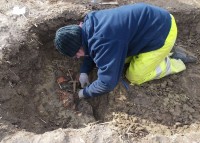 Last October, John Steele was scanning a field in Whitchurch, north of Aylesbury, Buckinghamshire, at a Weekend Wanderers metal detecting group rally when he discovered some fragments of iron and copper alloy artifacts. There were also pieces of red Samian ware vessels, an indication that the site may have been an ancient burial. The group alerted Finds Liaison Officer Ros Tyrell. Buckinghamshire County Council archaeologist Eliza Alqassar realized this could be a significant discovery and commissioned Oxford Archaeology to excavate the find site.
Last October, John Steele was scanning a field in Whitchurch, north of Aylesbury, Buckinghamshire, at a Weekend Wanderers metal detecting group rally when he discovered some fragments of iron and copper alloy artifacts. There were also pieces of red Samian ware vessels, an indication that the site may have been an ancient burial. The group alerted Finds Liaison Officer Ros Tyrell. Buckinghamshire County Council archaeologist Eliza Alqassar realized this could be a significant discovery and commissioned Oxford Archaeology to excavate the find site.
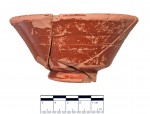 The excavation was challenging. Soil conditions were difficult and the earth had been churned up by heavy farming machinery leaving some artifacts so crushed and dispersed that it was hard to figure out what they were. Oxford Archaeology spent three days excavating and documenting the site. They found iron nails and organic deposits indicating there had once been a wooden burial casket 3’7″ long and 2’4″ wide buried at the site. The wooden structure of the casket has decayed, but it contents survived: a bronze jug with a decorated handle, two Samian ware cups, two Samian ware dishes, a pottery flagon, two glass vessels, a bronze patera (a shallow libation bowl), an iron lamp or lamp holder, two unidentified lead objects and a cremation urn.
The excavation was challenging. Soil conditions were difficult and the earth had been churned up by heavy farming machinery leaving some artifacts so crushed and dispersed that it was hard to figure out what they were. Oxford Archaeology spent three days excavating and documenting the site. They found iron nails and organic deposits indicating there had once been a wooden burial casket 3’7″ long and 2’4″ wide buried at the site. The wooden structure of the casket has decayed, but it contents survived: a bronze jug with a decorated handle, two Samian ware cups, two Samian ware dishes, a pottery flagon, two glass vessels, a bronze patera (a shallow libation bowl), an iron lamp or lamp holder, two unidentified lead objects and a cremation urn.
 The cremation urn was in such bad condition that archaeologists lifted the entire soil block around it for excavation back at the Oxford Archaeology lab. Inside the urn were iron hobnails from a shoe, a red jasper intaglio engraved with the goddess Minerva and a smaller figure, possibly Mercury, holding up a wreath. The cremated bone fragments belonged to an adult, possibly female, buried in the 2nd century.
The cremation urn was in such bad condition that archaeologists lifted the entire soil block around it for excavation back at the Oxford Archaeology lab. Inside the urn were iron hobnails from a shoe, a red jasper intaglio engraved with the goddess Minerva and a smaller figure, possibly Mercury, holding up a wreath. The cremated bone fragments belonged to an adult, possibly female, buried in the 2nd century.
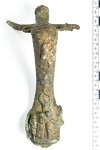 The wealth and rare combination of artifacts suggest she was someone of high status. Burials from this period containing objects in a variety of metals, glass and ceramics are very rare. There are only a handful of comparable rich cremation burials found to contain glass and bronze artifacts and lamps all unearthed in southeastern England (this burial in Wendover found in 2000 is comparable down to the original discovery by metal detectorists). The Whitchurch find is the westernmost of these burials. The iron lamp or lamp holder is also a rare find. The bronze jug handle, elaborately decorated
The wealth and rare combination of artifacts suggest she was someone of high status. Burials from this period containing objects in a variety of metals, glass and ceramics are very rare. There are only a handful of comparable rich cremation burials found to contain glass and bronze artifacts and lamps all unearthed in southeastern England (this burial in Wendover found in 2000 is comparable down to the original discovery by metal detectorists). The Whitchurch find is the westernmost of these burials. The iron lamp or lamp holder is also a rare find. The bronze jug handle, elaborately decorated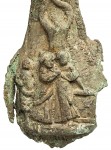 at the base with a sacro-idyllic scene of figures worshipping at an altar that has no known parallels. It’s a unique piece of national importance, especially since it was properly excavated in a dated and documented context.
at the base with a sacro-idyllic scene of figures worshipping at an altar that has no known parallels. It’s a unique piece of national importance, especially since it was properly excavated in a dated and documented context.
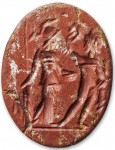 In the months since the discovery, three artifacts have been cleaned and conserved: the bronze jug handle, one of the Samian cups and the jasper intaglio. The three of them will be on display at the Buckinghamshire County Museum in Aylesbury for the next three months in a bid to raise interest and funds for thorough conservation of the rest of the metal artifacts. They need £3,000 to clean and stabilize the objects so they’re suitable for permanent display and for publication.
In the months since the discovery, three artifacts have been cleaned and conserved: the bronze jug handle, one of the Samian cups and the jasper intaglio. The three of them will be on display at the Buckinghamshire County Museum in Aylesbury for the next three months in a bid to raise interest and funds for thorough conservation of the rest of the metal artifacts. They need £3,000 to clean and stabilize the objects so they’re suitable for permanent display and for publication.